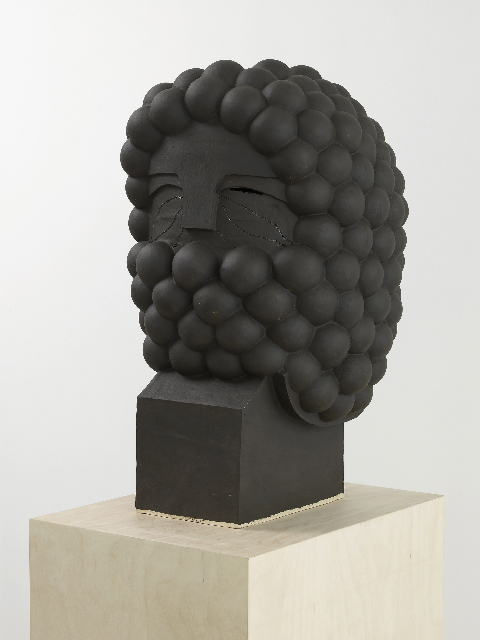


Renee So, Bellarmine IX, Bellarmine X and Untitled, 2012
With their penchant for drunken acrobatics and big jolly beards, the characters Renee So brings to life are a lovely gang of odd bods. In the giant “knitted portraits” she creates on a 1970s pre-computerised machine, her figures – who wear ballooning Elizabethan trousers and top hats and carry canes or clay pipes – seem to have been rummaging in history’s dressing-up box. Meanwhile, their flat, 2D forms and rigid poses resemble ancient tapestries, friezes and cartoons all at once.
They have coloured beards that cover their mouths like bubble bath foam. Their eyes are mysterious – are they laughing or glaring? So’s ceramic busts are similarly intriguing. Their hair is made from Malteser-like brown orbs, and their masks resemble Roman helmets. Some have double heads, like kings in a pack of cards; some wear hats. They’re comic and stoic, taking our smiles with dignity.
Born in Hong Kong and raised in Australia, So’s earlier work addressed her dual heritage. A self-confessed “craft nut”, she turned to knitting to create images that referenced tourist export chinoiserie and its trade routes. Since moving to London in 2005, she’s looked at the history of European sculpture, both grand and humble. While her masked ceramics suggest armoured soldiers and curly-haired Caesars, she also uses pottery to portray a more knavish people’s hero: Bartmann.
She discovered Bartmann, or Bellarmine, stoneware in the V&A and was immediately hooked by its convoluted history. First brought to Britain from Germany in the 1500s, Bellarmine beer jugs double up as depictions of bulbous bearded men, descendants of the Wildman of medieval folklore. Their name is a jibe at an unpopular cardinal who condemned drinking. They were a sure-fire hit, and their fame mushroomed.
So sets this figure free from his roots as a mass-produced beer mug. In her sculptures and knitted portraits, we glimpse surreal transhistorical tales where dandies, drinkers, kings and soldiers are one and the same. Inviting us to imagine the backstory, these inscrutable bearded and masked players show that identity is a shifty business, built on tangled traditions and stereotypes.